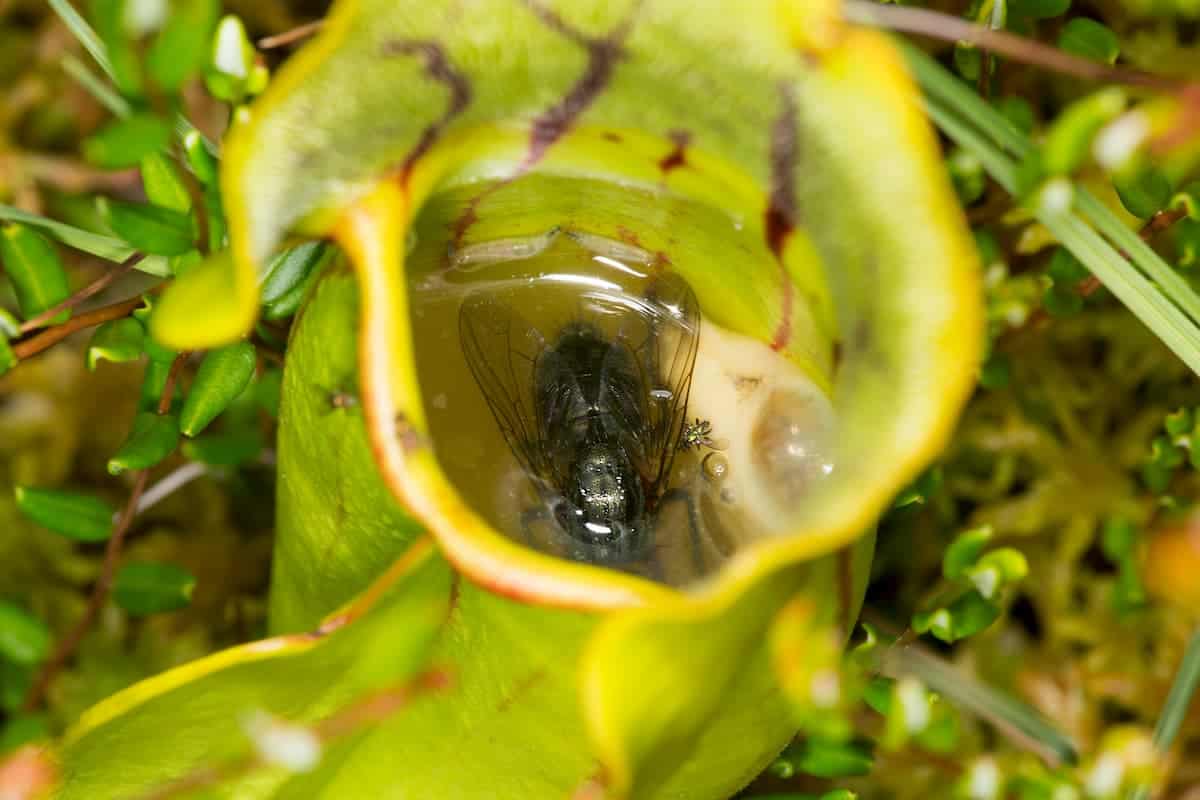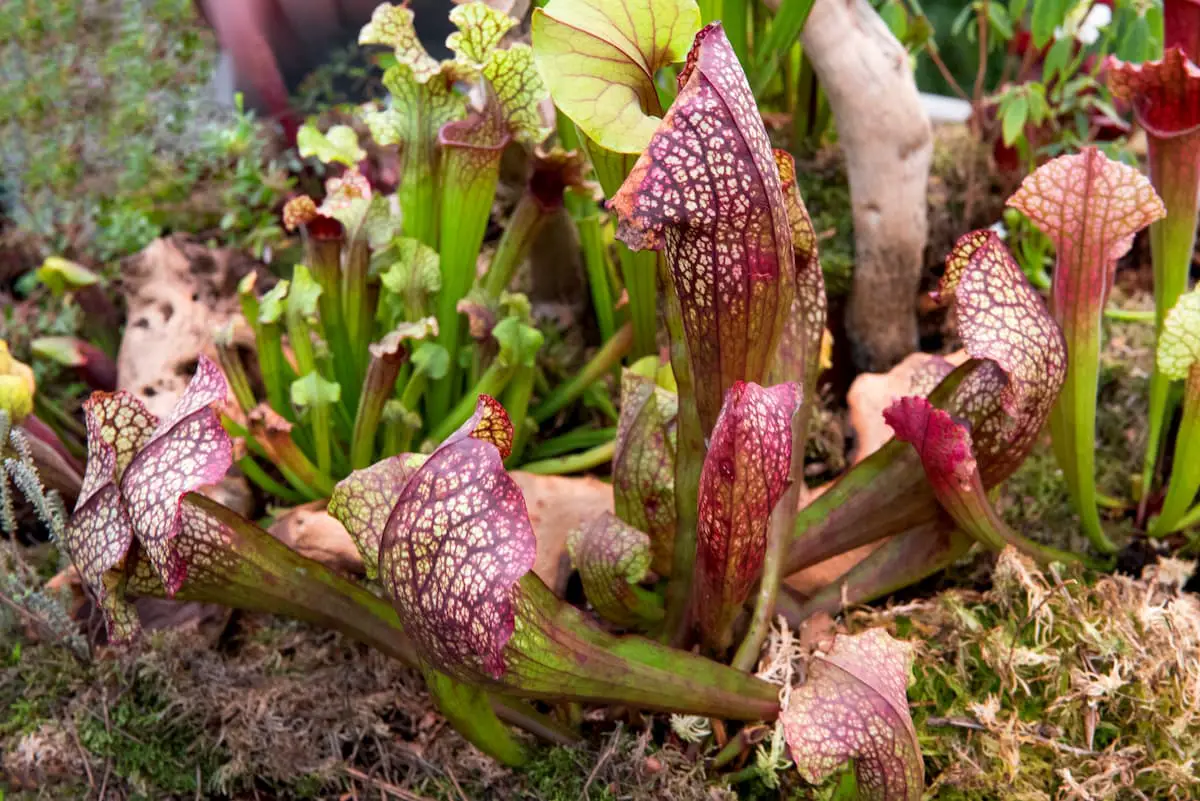When I first started to look into raising carnivorous plants I was only aware of the Venus Flytrap and was aware of the jaws of death it had. I probably couldn’t have been further from the actual truth but it started me down the road to understanding there are a tremendous amount of different traps which many plants have developed over time.
How Do Carnivorous Plants Catch Their Prey? All carnivorous plants catch their prey via a trap system which can range from active, semi-active, and passive. The five main trap types which exist are pitfall, sticky, lobster pot, suction and the favorite snap.
Now we will explain each of the main traps and how each one helps the plant which uses it. This list should help provide you a quality understanding as to why each trap is unique and how they provide an end to animals who are caught.
There Are Five Trap Types In Carnivorous Plants
Hopefully you are interested in understanding more about the 5 types of traps involved in carnivorous plants and are willing to learn. Whether to just get the knowledge or to start raising the plants yourself, I hope this is as useful for you as it was for me when I first learned about it!
The Pitfall Trap
A Pitfall trap is the single most simple trap that many carnivorous plants will use, this is also called the pitcher trap. This trap is typically the simplest to understand as it only has two parts involved.
A pitfall trap simply is a pit into which the prey fall, once they are inside they are unable to then escape. Then the slow process to digest the prey begins as the liquid contained in the pitfall trap is made up of rainwater and digestive enzymes or bacteria.
When the prey falls in they will fight to leave, eventually running out of energy and drowning. When this happens they sink to the bottom of the pit, then the insect carcass is digested by either enzymes, bacterial action, or other small organisms.
In evolution it comes as no surprise this type of trap could become viable, since it is just a shaped leaf which curls around into a pitcher. This may have even first started to allow the plant to capture more moisture from the air and rain as they are frequently in very poor nutrient soil areas.
If plants, which were barely living or surviving in a nutrient poor condition, evolved this method to obtain nutrients it would have been a game changer and a large benefit to overall survival.
No matter how simple a trap may appear there are always consistent evolutionary changes which can make it more successful. Most of the pitfall traps feature additional tricks up their sleeves to pull in prey, from hairs which point downward to make climbing difficult to sweet smelling nectars to draw in more insects.
One other additional feature to pitfall trap plants is that they are typically brightly colored to trick insects into coming closer. These colors may be there to help influence prey into coming closer believing them to be flowers and blooms. Additionally, there are some pitcher plants which produce an odor that may be attractive to insects.
One other common addition most pitchers will have to them is a leaf lid over the top of their pitcher. This serves at least 2 purposes in that it keeps excessive rain water out of the pitcher which could cause tipping, and the second which is that inclusion of too much water could dilute the digestive system overall.
Another benefit to having a lid is that it can be a nice place for bugs to land and to get within range of the trap. Having this be as close to the mouth of the pitcher would help increase the amount of insects which could be caught.
The Sticky Trap
As plants have evolved they developed defense systems around attacking insects bystanders using mucus or a sticky substance they can express out of glands. This allows them to survive an invasion by catching the attackers and leaving them stranded in place unable to escape and slowly dying.

If you know that this defense exists in standard plants, like a tomato plant, then it isn’t a large jump for evolution to start using these caught insects offensively. What if, instead of the insects just dying and then slowly falling off over time the plant was to use these caught insects for nutrients?
While some don’t believe in evolution, the carnivorous plants are proof that over time everything on this planet adjusts to survive and thrive.
Now as to how these sticky traps provide nutrients to the plants, there are 2 primary methods involved which are digestion from symbiotic bugs and insects who live and work in tandem with the plant or as other carnivorous plants have shown, they bend their tentacles towards the prey, enveloping them to start digestion. While this movement of tentacles may look like it is intended to hold the prey, it really serves more of a purpose to stop other insects from attempting to steal the food.
Lobster Pot Traps
Similar to how a person makes a fish trap where the fish come in but cant find their way out, a lobster pot, instead of just falling into a pitcher, baits the prey into trapping itself within the trap. The prey basically marches itself into the trap and pushes itself until it can no longer escape.
Lobster pot traps use tricks to lure in the prey, typically this occurs by leading them on with the belief that food is just around the corner. This lure has them walk willingly into the mouth to become trapped, and to start being digested slow and inevitably.
In many of the lobster trap plants, the inflated pitcher chamber is filled with a transparent area which helps illuminate the entry chamber, encouraging the bugs to enter and never leave.
From the evolutionary perspective, a lobster pot trap is basically just a retrofitting or modification of the pitfall trap.
Suction Traps
In a suction based trap the organ is a smaller pouch which is flexible and able to bulge outward towards the prey. The trap will prepare itself for hunting by pumping fluid out of the interior using special internal glands.
Basically, the trap relies on the prey wandering up to the bladder. No one is quite certain how the bladder actually attracts prey, or if it just relies upon the occasional blundering of foraging creatures.
The cool part happens when a creature bumps into the hairs near one end of the bladder. A trap door then opens in the bladder, and the water is allowed to rush into the bladder which replaces the water that was pumped out previously. The prey is then swept in with the rush, and is propelled into the bladder where the digestive enzymes are released and the prey is consumed.
An interesting fact is that the suction traps are known only in one genus–Utricularia.
There is very little overall understood about the suction traps, like many species are often brilliantly colored. Which is odd as almost all tiny aquatic organisms cannot see well, so why are the traps so colored?
Snap Traps
These are the traps that most of the world is very familiar with, they are only found in two related plants, Venus Flytraps and the waterwheel. The Venus Flytrap only operates above water and the Waterwheel actually resides fully underwater.

In the snap trap, the leaf has two lobes that are splayed widely apart. Foraging or exploring insects wander into the trap, and trigger it by stimulating a the nearly invisible trigger hairs on the trap walls.
As soon as the trap is triggered, it snaps shut, making a little prison for the creature. The little animal runs back and forth, and in doing so stimulates those trigger hairs again and again. This causes the plant leaves to tighten, seal, and then release digestive enzymes eventually causing them to die by suffocation.
Bottom Line
Whatever trap is the one you find the most intriguing choosing a carnivorous plant is a much more fun shopping trip than most standard shopping trips. Allowing you to find the matching plant to your location and your personality affords you a chance to bring a little bit of yourself into the plant.
Though I will always favor the Venus Flytrap as it is stuck in my head, my next plant will be a pitcher, as there is just something awesome and awe inducing over the simplicity and elegance the traps provide. What is your choice out of the traps above, comment below and let me know!



Leave a Reply